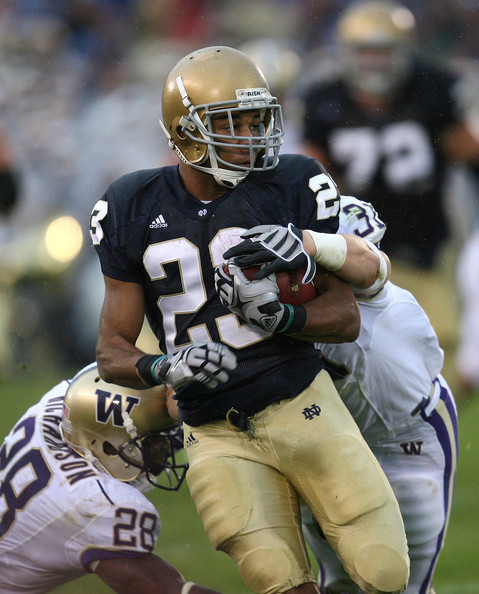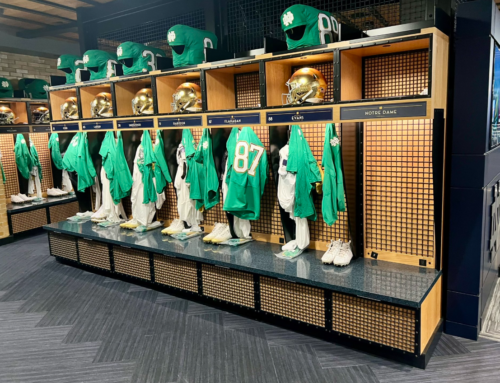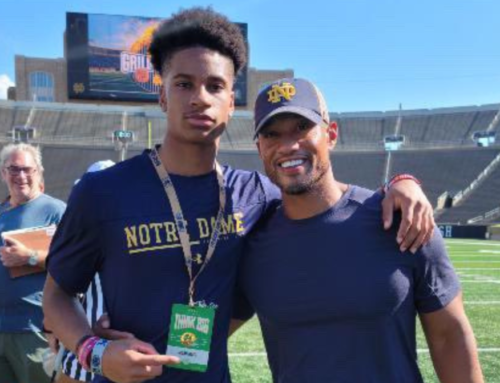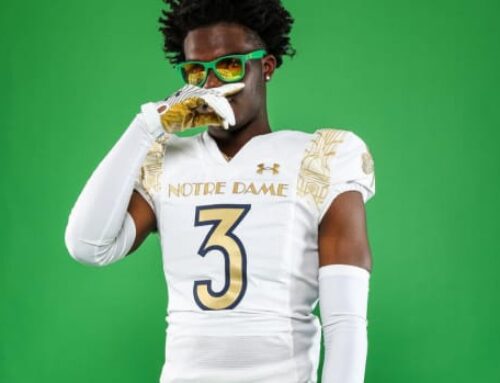Welcome back to our deep dive series on Irish football recruiting rivalries. There are a few key schools who make you go all Captain Kirk when they sign a Notre Dame target, because DAMMIT THEY DID IT AGAIN. We’re talking about those schools. We kicked off the series with a takedown of the Tree, continued by poking the Wolverine(s), circled our Conestoga wagons to limited effect, confirmed that the buckeye nut is indeed poisonous (really!), and recently discovered that encounters with the Trojans don’t always end in as much fun as we’ve been led to believe.
We conclude our series today by checking how the Irish have fared against that most vicious animal of the Pacific Northwest, the Washington Husky. It’s sort of as bad as you think and also sort of better than you think. We’re complicated people.
Methodology
I’m going to include every commit who had offers from the other team in the win/loss counts, even if I know those offers weren’t really committable in some cases. This is because while I know that in some cases, I’m aware that neither I nor anyone else truly knows the status of all offers. Plus I have much more intimate knowledge of Notre Dame recruiting than opponents’ recruiting, of course, and it would be intellectually dishonest of me to say “they got recruit X because we didn’t push” and ignore the potential for that to happen in the other direction as well.
I broke the Kelly Epoch down into three distinct chunks to compare these rivalries: the 2011-14 classes, which we’ll call the Diaco Era, the 2015-17 classes, which we’ll call the BVG Era, and the 2018-20 classes, which we’ll call the Revival Era. Notre Dame’s on-field record in those three eras are, in order, 37-15, 22-16, and 22-4. Keep those in mind as you consume the other info here, as they’re obviously major factors in themselves. Note that while I’m using the DC’s names, we’re still looking at recruits on both sides of the ball in those eras. It’s just a convenient nomenclature.
Finally, we’ll cap each review with a quick look at the 2018-2020 cycles. Those are the ones that coincide with a better on-field product and a more recruiting-focused coaching staff, which should give us more of a sense of what is possible when things are going well.
The Scoreboard
| Wins | Losses | |||
| Year | Off | Def | Off | Def |
| 2011 | 1 | 1 | 0 | 0 |
| 2012 | 3 | 1 | 3 | 1 |
| 2013 | 0 | 2 | 1 | 2 |
| 2014 | 1 | 5 | 0 | 2 |
| 2015 | 2 | 0 | 0 | 0 |
| 2016 | 2 | 0 | 0 | 2 |
| 2017 | 1 | 1 | 1 | 1 |
| 2018 | 0 | 1 | 1 | 3 |
| 2019 | 0 | 2 | 3 | 7 |
| 2020 | 1 | 1 | 2 | 0 |
| 11 | 14 | 12 | 18 | |
| 25 | 30 | |||
| 45.5% | ||||
The total number problem isn’t as bad as you thought it would be, right? They’ve pulled off some wins, and some of those wins have been particularly painful. They’ve also lost more to us than you might have imagined. What’s especially notable is that 49 of these 54 recruits came from no further east than Denver, and that oddly enough all five who were from farther east than that were in the 2014 cycle. Perhaps not surprisingly, Notre Dame took all five of those kids. When we match up against Washington we’re typically trying to pull regional kids away from them, often in areas where they do quite well. Like with USC, you’d expect us to come up short a lot but would like to see us do better than we have with the kids who are a good fit for Notre Dame.
Wins and Losses
| Win % by Era | |||
| All | Off | Def | |
| 2011-14 | 61% | 56% | 64% |
| 2015-17 | 60% | 83% | 56% |
| 2018-20 | 23% | 13% | 29% |
At first glance it’s a bit hard to know what to make of these numbers. Defense dips a bit in the BVG Era while offense jumps substantially, which counters the trends elsewhere, but both tank in the Revival Era, which also counters the trends elsewhere. Chris Petersen’s first full cycle was in 2014 and Irish recruiting nemesis Jimmy Lake came with him from Boise State, so they don’t explain the sudden downturn in the Revival Era.
I think there are two things at play: the relatively small sample size of common targets, and what looks like one very aggressive cycle for Notre Dame in 2019. In the four cycles from 2015-18, Notre Dame and Washington shared 15 targets; in 2019 they shared 12, at least five of whom were never going to have any interest in the Irish. Maybe the staff just decided to try their luck that year.
Quality Control
| Avg. 247C Score – Offense | |||
| W | L | Diff | |
| 2011-14 | 0.9307 | 0.9282 | 0.0025 |
| 2015-17 | 0.9365 | 0.9105 | 0.0260 |
| 2018-20 | 0.9671 | 0.9258 | 0.0413 |
| Avg. 247C Score – Defense | |||
| W | L | Diff | |
| 2011-14 | 0.9205 | 0.9265 | -0.0060 |
| 2015-17 | 0.8708 | 0.9249 | -0.0541 |
| 2018-20 | 0.9256 | 0.9281 | -0.0025 |
Again, sample size warnings abound. They took just one offensive player from us in the three years of the BVG Era (WR Terrell Bynum), while we’ve taken just one offensive player from them in the three years of the Revival Era (OT Tosh Baker). That tends to mess with the results, so keep that in mind. That said, we do see a repeat of the general trend in all the other articles – doing OK on both sides in the Diaco Era, cratering on defense in the BVG Era, and rebounding on defense in the Revival Era.
Highlights/Lowlights
Lemon juice on your paper cut in the form of some of Washington’s more notable wins:
- Five-star S Shaq Thompson, 2012: Thompson took an official visit to Notre Dame for the disastrous 2011 USC game. No doubt Ozzie’s maniacal cackle was still ringing in his ears when he signed with Washington a few months later.
- Top 100 WR Jalen McMillan, 2020: His coach’s daughter was student manager for Kelly. His high school is very similar to Notre Dame. He loved his unofficial visit in April. He planned a return trip for the USC game in the fall for his official visit. And then he committed to Washington. Fresnophobia strikes again… McMillan is one of those kids that we “should” win, a perfect fit on and off the field for Notre Dame. This one hurt.
- Top 100 S Budda Baker, 2014: Committed to Oregon but Washington’s then-new coach Chris Petersen, who is totally not a vulture, continued to recruit him and earned the flip. Never truly considered leaving the region.
- Four-star CB Salvon Ahmed, 2017: Another perfect fit for Notre Dame who had the bad fortune of witnessing the 2016 Michigan State debacle in person. The Washington native, not surprisingly, elected to stay home. He ended up at running back for the Huskies.
- Four-star CB Trent McDuffie, 2019: McDuffie visited on his own dime as a junior to catch the Irish wreck the other Miami, but never returned.
- Four-star S Julius Irvin, 2018: Irvin was set to sign early with Notre Dame over USC when his mother received a cancer diagnosis and he backed off. He ended up signing with Washington a couple of months later to stay closer to home (sort of).
- Four-star CB Kyler Gordon, 2018: Yet another excellent Notre Dame fit who came down to the Irish and the Huskies and, unlike fellow Everett native Keivarae Russell, chose the bad guys. Notre Dame was again swimming uphill with a local kid but it looked right up until the last minute like they had a real chance.
- Four-star S Asa Turner, 2019: Was ready to sign with Notre Dame in December but held off, reportedly because he was torn between playing linebacker (where Notre Dame wanted him) and safety (where Washington pretended he could stick). He played safety in the Polynesian Bowl and had a great time, and that was the final nail in the coffin of this recruitment.
And now some Neosporin in the form of the most notable Notre Dame wins:
- Five-star S Max Redfield, 2013
- Top 100 CB Tee Shepard, 2012
- Top 100 WR Davonte Neal, 2012
- Top 100 LB Nyles Morgan, 2014
- Top 100 OT Tosh Baker, 2020
- Top 100 OC Tristen Hoge, 2015
- Top 100 LB Jack Lamb, 2018
- Four-star DE Jordan Botelho, 2020
- Four-star WR Javon McKinley, 2016
- Four-star OT Ronnie Stanley, 2012
- Four-star CB Keivarae Russell, 2012
- Four-star CB Cole Luke, 2013
- Four-star WR Equanimeous St. Brown, 2015
- Four-star WR Chase Claypool, 2016
- Four-star OT Aaron Banks, 2017
- Four-star CB Nick Watkins, 2014
- Four-star DE Isaiah Foskey, 2019
So we’ve done OK overall. The problem is losing a few key guys at – and this is the really critical part – key positions over the last few cycles more than a general failure to recruit against Washington.
As a side note, those five non-regional recruits I mentioned earlier, ordered by 247 Composite rating:
- Nyles Morgan
- Nick Watkins
- Jay Hayes
- Grant Blankenship
- Jhonny Williams
Truly strange that that was the one cycle where they went out of the region, and they went out of it with a vengeance. That was the Sark-Petersen transitional class; I didn’t check the timing of the offers, and it could well be that Petersen just tossed offers all over the place in an attempt to fill out the class. That would make some sense, especially given that Hayes, Blankenship, Johnson, and Williams didn’t exactly have elite programs beating down their doors. But it’s still odd.
Recent History
| 2018 | |||||
| Notre Dame | Washington | ||||
| ILB | Jack Lamb | 0.9547 | DT | Tuli Letuligasenoa | 0.9517 |
| S | Julius Irvin | 0.9361 | |||
| CB | Kyler Gordon | 0.9256 | |||
| OG | Sam Taimani | 0.9190 | |||
| 2019 | |||||
| Notre Dame | Washington | ||||
| WDE | Isaiah Foskey | 0.9164 | DT | Faatui Tuitele | 0.9609 |
| OLB | Marist Liufau | 0.8842 | CB | Trent McDuffie | 0.9442 |
| WDE | Laiatu Latu | 0.9435 | |||
| QB | Dylan Morris | 0.9304 | |||
| ILB | Daniel Heimuli | 0.9187 | |||
| ILB | Josh Calvert | 0.9144 | |||
| S | Asa Turner | 0.9007 | |||
| OT | Julius Buelow | 0.8958 | |||
| OG | Troy Fautanu | 0.8912 | |||
| WDE | Bralen Trice | 0.8850 | |||
| 2020 | |||||
| Notre Dame | Washington | ||||
| OT | Tosh Baker | 0.9671 | WR | Jalen McMillan | 0.9752 |
| WDE | Jordan Botelho | 0.9471 | OT | Roger Rosengarten | 0.9472 |
| OG | Geirean Hatchett | 0.9217 | |||
We were never even remotely on the radar of Letuligasenoa, Tuitele, Latu, Heimuli, or Fautanu. Washington’s regional attraction plus its long-standing tradition of providing a home for Poly kids ended those battles before they started.
In 2018, Irvin and Gordon were kids the staff put a lot of effort into and lost. No sugar-coating it. Taimani really liked Notre Dame but was an admissions casualty. Washington would’ve loved to land Lamb, of course.
In 2019, Morris tried to commit to Notre Dame but was told his spot was taken by Cade McNamara, who later flipped to Michigan. Thanks, kid. We covered McDuffie and Turner already. The staff wasn’t sold on Calvert and never really pushed for him. They did want Buelow, who camped at Notre Dame but that was it, and Trice, who was unanimously predicted to Notre Dame on 247’s Crystal Ball feature until the day of his commitment to Washington. Recruiting is a funny game. Of course the Irish ended up landing Foskey, who Washington really wanted, and Nana Osafo-Mensah, so it worked out OK.
2020 is more or less even to this point. Washington definitely wanted Baker and Botelho badly, and in fact some Washington faithful are convinced that Botelho will still visit after being “forced” into committing to Notre Dame (not true on either count, according to people who actually would know). Similarly, Notre Dame really wanted McMillan (and will still push for him, although success is unlikely) and would’ve gladly added Hatchett to a small OL class. Rosengarten is technically a win for Washington, but Notre Dame stopped recruiting him after his visit in the spring; neither side saw the other as a fit.
Closing Thoughts on the Rivalries
A few odds and ends to put a bow on the series… Here is the list of rivalries ordered by the number of common targets in the Kelly Epoch:
- Ohio State, 166
- Michigan, 147
- USC, 111
- Oklahoma, 106
- Stanford, 87
- Washington, 55
And ordered by Notre Dame’s overall win percentage:
- Michigan, 57.1%
- Stanford, 50.6%
- Washington, 45.5%
- Oklahoma, 42.5%
- Ohio State, 40.4%
- USC, 36.0%
And ordered by the average 247 Composite score of Notre Dame’s wins:
- vs. USC, 0.9435
- vs. Oklahoma, 0.9353
- vs. Ohio State, 0.9329
- vs. Washington, 0.9264
- vs. Stanford, 0.9244
- vs. Michigan, 0.9223
And finally, ordered by the average 247 Composite score of Notre Dame’s losses:
- Ohio State, 0.9562
- USC, 0.9531
- Michigan, 0.9282
- Stanford, 0.9265
- Washington, 0.9264
- Oklahoma, 0.9163
These numbers need waaaaaaay more context than I can get into here for a really meaningful analysis, but I would suggest the main takeaway is this: Consider whether we should really get that hung up on the losses to Washington, Stanford, Oklahoma, or even Michigan. The losses to Ohio State and USC have the potential for a much greater impact if the staff can turn those around. Additionally, this isn’t a closed system – the staff can also address those shortfalls in head-to-head battles with Ohio State and Southern Cal by doing better with other five-stars. Brave thinking, I know, but I’m here to come up with the really innovative ideas.
On second thought, feel free to get hung up on the losses to Michigan. Those poor misguided youths will need our sympathy.





So if we could choose one school to lose a championship quality coach and replace him with a possibly much less capable coach then it should be Ohio State. Crossing my fingers.
That response is much to logical for college football. Don’t forget the hate and disdain felt for the skunk bears and U$C. For me, football is just as much about my hated of certain teams as it is my love for the Irish.
Great series of articles — they provided a nice perspective on ND’s successes and struggles with recruiting. It seems that ND does pretty well against some peer schools such as Stanford and Michigan, but runs into some walls when it comes to top schools, location, shopping down a different aisle, or some combination of those.
Looking back on the history, it is amazing that this program did as well as it did despite the recruiting shortcomings of coaches like BVG. I like the current direction, and hopefully some consistent winning seasons can help nudge the successes up even further.